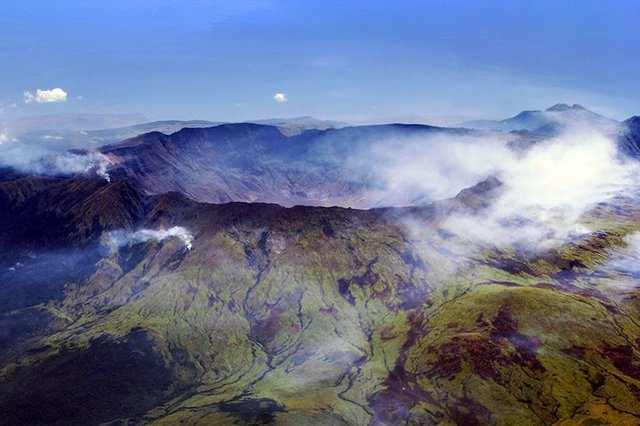FACT CANNON #2: How Frankenstein Was Born In The Fiery Heart Of A Super Volcano
FACT CANNON: Fascinating facts to fire at your friends, family and colleagues.
Mount Tambora

Mount Tambora is a super volcano situated on the island of Sumbawa in Indonesia. It erupted on 5 April 1815, ejecting around 9.8 cubic miles of pyroclastic trachyandesite rock and ash up to 18 miles into the air, and leaving a caldera more than 4 miles across. The explosive eruption was heard more than 1600 miles away on the island of Sumatra, and while molten lava was flowing at distances of up to 12 miles from the summit, ash triggered a zone of pitch darkness extending more than 300 miles around Sumbawa. A 4 meter tsunami was also generated, which laid waste to crops and housing throughout many of Indonesia’s islands. On Sumbawa and neighbouring Lombok, the local devastation, and famine caused by crops being buried under ash falls up to a meter deep, resulted in around 100,000 deaths.
Further afield from this hellish epicentre, the eruption also had a profound effect on the global climate. The huge amount of ash injected into the stratosphere caused a volcanic winter that encircled the planet in it’s cold, dark grip for more than a year, leading to 1816 becoming known as ‘The Year Without A Summer’. During this year, Earth’s average temperature fell by almost 1°C, with frosts reported all year round in the US in the states of New Hampshire, Maine and Vermont, and snow falling in New York and Maine in early June. The inclement weather triggered multiple crop failures across Western Europe, and, along with the ensuing die off of livestock, led to widespread famine and rioting across the continent. Climatic changes also drove changes in bacterial fauna, leading to a catastrophic cholera pandemic originating in India that would claim more than 15 million lives across Asia and Europe over the following 50 years.
The Shelley's Geneva Vacation
On the positive side, beautiful sunsets were seen globally for much of the year, which may have fuelled Mary Godwin and future husband Percy Shelley’s decision to spend the summer at the Villa Diodati in Lake Geneva, Switzerland, with soon to be friend Lord Byron and his personal physician John Polidori. Sadly, although Switzerland probably did not suffer the red and brown snows that fell upon Italy and Hungary, it had not been spared the abysmal weather; and famine and disease were fuelling poverty and unrest among the local peasantry.
I'm guessing that this put something of a dampener on the Shelley’s plans!
The conversation probably went something like this:
Mary: 'Oh Percy, we’ve been here a week and haven’t been out yet. Do let's go for a picnic today, cook has prepared some most delightful cucumber sandwiches.'
Percy: 'But Mary, it's still raining cats and dogs outside, and it’s so very very dark, besides, there’s lots of peasants hanging around and they look like a ghastly bunch of ruffians. Anyway, Byron tells me he’s got a spiffing new batch of laudanum in. Let's get off our lobes instead.'
Mary: 'Oh, you boys are such beastly rascals. I simply can't bear another day listening to Byron's dreary poetry, and besides he's in one of his moods again. I'm going to lock myself in my chambers and write the world's first horror story instead. I shall call it ‘Frankenstein, The Modern Prometheus’'.

And so Frankenstein was born, alongside Byron & Polidori’s joint effort which was to evolve into the novel ‘The Vampyre’, the first modern vampire tale, and likely inspiration for Bram Stoker’s ‘Dracula’.
Elsewhere in Europe, the lack of any healthy horses to pull carts also inspired German inventor Karl Drais, to invent the velocipede, a forerunner of the modern bicycle.
What Ifs
In considering Frankenstein’s subtitle, it’s interesting to ponder whether Mary Shelley somehow realised that Mount Tambora had set in action a chain of events that led to her monstrous creation, whether she felt she had somehow stolen fire from the gods of Mount Tambora in a manner similar to the Greek Titan Prometheus’ theft from Mount Olympus.
Whether or not this was the case, it’s also fascinating to deliberate how the world would look today if the conditions of the Mount Tambora eruption had differed. Had the eruption not occurred, the horror genre may never have been spawned, and we may live in a world barren of classics such as The Exorcist, Poltergeist, The Shining, and of course The Walking Dead. On the other hand, had Tambora spewed out just 10 times the amount of ash, then our world could now be absent of any form of civilization. In fact, it is possible that huge numbers of species, including humanity, could have vanished in what might have been an apocalyptic volcanic winter.
Either way you could also kiss your bicycle goodbye!
Inspiration:
https://en.wikipedia.org/wiki/Mount_Tambora
https://en.wikipedia.org/wiki/Year_Without_a_Summer
https://en.wikipedia.org/wiki/Mary_Shelley
https://en.wikipedia.org/wiki/Cholera_outbreaks_and_pandemics
Previous editions of FACT CANNON:
If you’re enjoying the FACT CANNON series, please upvote, comment, share and follow me. I'd love to turn this into a regular series, but it really depends on your support - that's right, trend me! In return I’ll provide a barrel load of facts for you to barrage your friends with!
Great Writing
Keep it up :D Following. ;)
Cheers! Thanks for your support, its appreciated!
@matrioshka Loved this post of yours. :)
Very glad you enjoyed it!
Tell your friends, and I'll write more! :-)
Linked here from @Alienbutt and found it fascinating thanks.